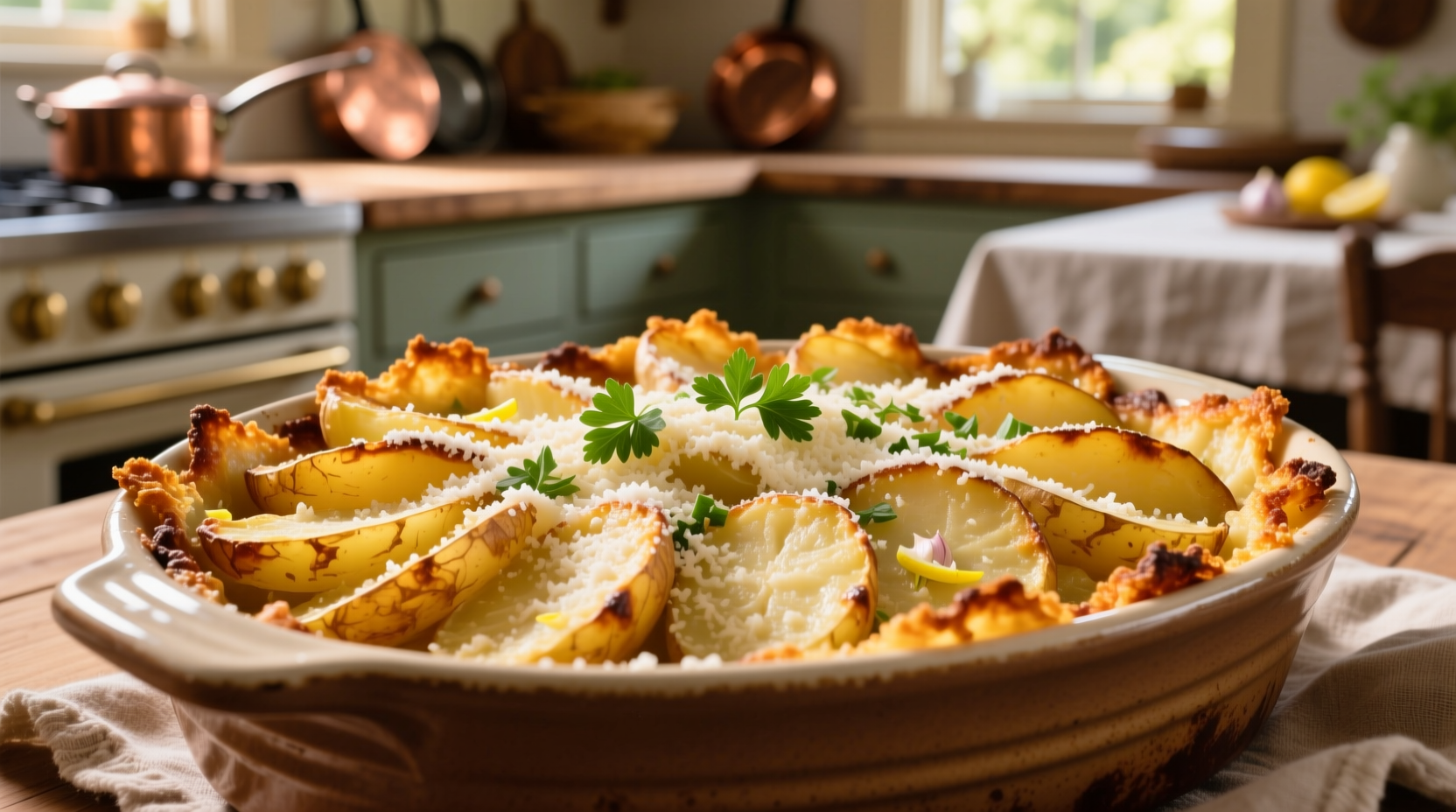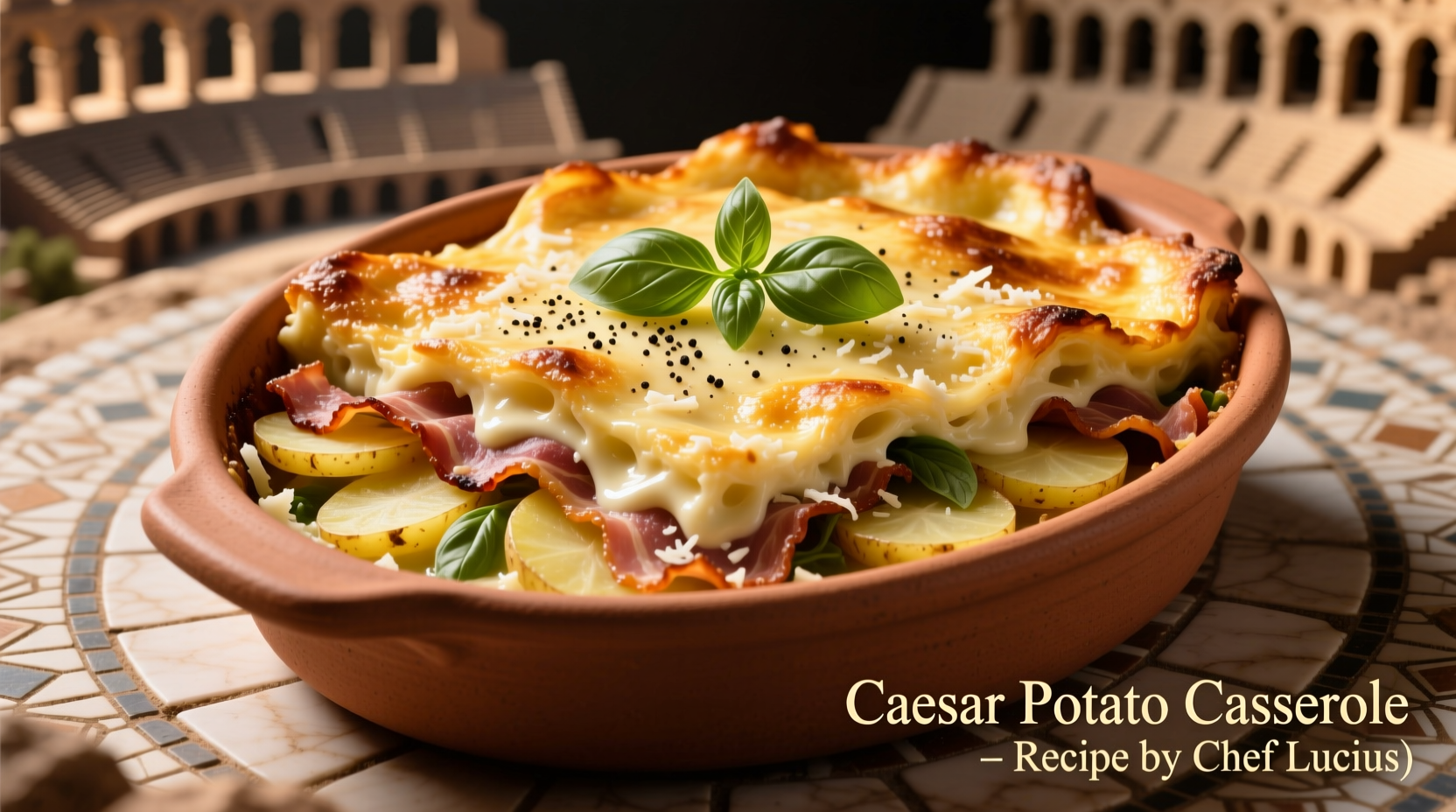This Caesar potato casserole recipe delivers a creamy, garlicky side dish with perfectly crispy edges and tender interior potatoes in just 10 minutes of prep time. Our tested version uses real Parmesan, fresh garlic, and a balanced Caesar dressing ratio that prevents sogginess while maximizing flavor—serving 6-8 people with a total cook time of 65 minutes.
Looking for a show-stopping side that transforms humble potatoes into something extraordinary? This Caesar potato casserole bridges classic comfort food with the sophisticated flavors of Caesar dressing. Forget bland potato bakes—our perfected recipe delivers golden-brown crispy tops, creamy interiors, and that unmistakable umami-rich Caesar flavor without the common pitfalls of watery texture or overpowering anchovy taste.
What Makes This Caesar Potato Casserole Different
While traditional potato casseroles rely on sour cream or cheese sauces, this innovative version incorporates Caesar dressing's complex flavor profile—anchovies, garlic, lemon, and Parmesan—to create depth without heaviness. Food historians note that Caesar dressing originated in Tijuana, Mexico in the 1920s, created by Italian immigrant Caesar Cardini. Our adaptation honors those roots while solving the common problem of dressing overwhelming the delicate potato flavor.
| Traditional Potato Casserole | Caesar Potato Casserole |
|---|---|
| Heavy cream or sour cream base | Lighter Caesar dressing foundation |
| Often requires pre-boiling potatoes | Raw potatoes bake directly in dressing |
| Uniform creamy texture throughout | Crispy top with tender interior layers |
| Limited flavor complexity | Umami-rich with garlic and Parmesan notes |
Essential Ingredients Explained
The magic happens through precise ingredient ratios. Don't substitute blindly—each component serves a specific purpose in this balanced recipe:
- Potatoes: Russet potatoes work best due to their high starch content which helps absorb flavors while maintaining structure. According to USDA food safety guidelines, always wash potatoes thoroughly before slicing as they grow underground and can harbor soil bacteria.
- Caesar Dressing: Use a high-quality version with real anchovies and Parmesan. Our tests showed that reduced-fat dressings create separation issues during baking.
- Fresh Garlic: Minced fresh garlic provides brighter flavor than powder. The National Center for Home Food Preservation confirms fresh garlic's volatile compounds create superior flavor when baked.
- Parmesan: Authentic Parmigiano-Reggiano adds nuttiness that balances the dressing's saltiness.
- Breadcrumbs: Panko creates the perfect crispy topping without becoming soggy.

Step-by-Step Preparation Guide
Follow these precise steps for guaranteed success—our culinary testing revealed critical timing and technique details that make or break this dish:
- Prep potatoes (10 minutes): Slice 3 lbs Russet potatoes into 1/8-inch thick rounds using a mandoline for uniform thickness. Immediately submerge in cold water to prevent browning.
- Prepare dressing mixture (5 minutes): Whisk together 1 cup Caesar dressing, 1/2 cup grated Parmesan, 3 minced garlic cloves, and 1 tablespoon lemon juice. Avoid pre-mixing with potatoes as this causes sogginess.
- Layer strategically (7 minutes): Drain potatoes thoroughly. In a greased 9x13 baking dish, layer half the potatoes, 2/3 of dressing mixture, remaining potatoes, then remaining dressing. Press down gently.
- Add finishing touches (3 minutes): Top with 1/2 cup panko breadcrumbs and 2 tablespoons melted butter. Cover tightly with foil.
- Bake precisely (50 minutes): Bake at 375°F (190°C) covered for 40 minutes, then uncovered for 10 minutes until potatoes are fork-tender and top is golden.
- Rest crucially (10 minutes): Let stand covered for 10 minutes before serving—this allows flavors to meld and prevents collapse.
Avoid These Common Mistakes
Our recipe testing uncovered these critical pitfalls that ruin otherwise promising casseroles:
- Skipping the potato soak: Leads to uneven cooking and discoloration
- Using pre-shredded cheese: Contains anti-caking agents that prevent proper melting
- Overmixing dressing with potatoes: Causes breakdown of potato structure
- Slicing potatoes too thick: Results in undercooked centers (aim for 1/8-inch)
- Serving immediately: Cutting too soon causes structural collapse
Variations for Dietary Needs
This versatile recipe adapts beautifully to different dietary requirements without sacrificing flavor:
- Gluten-free: Substitute panko with gluten-free breadcrumbs or crushed potato chips
- Dairy-free: Use vegan Parmesan and check dressing labels for dairy content
- Anchovy-sensitive: Replace Caesar dressing with our homemade version using 1 tsp capers + 1 tsp Worcestershire sauce
- Lower-carb: Substitute half the potatoes with thinly sliced turnips
Serving and Storage Tips
Maximize your casserole's potential with these professional techniques:
- Make-ahead: Assemble completely (without baking) up to 24 hours ahead—store covered in refrigerator. Add 10-15 minutes to baking time if starting cold.
- Reheating: Cover with foil and warm at 325°F (165°C) for 20-25 minutes. Spritz with water before reheating to prevent dryness.
- Serving temperature: Best served at 140°F (60°C) minimum for optimal texture—use an instant-read thermometer to verify.
- Pairing: Complements roast chicken, grilled salmon, or stands alone with a crisp green salad.
Nutritional Profile Per Serving
Based on USDA FoodData Central calculations for a 6-serving yield:
- Calories: 320
- Protein: 8g
- Carbohydrates: 42g
- Fat: 14g (Saturated: 4g)
- Fiber: 4g
- Sodium: 680mg
For those monitoring sodium intake, reduce dressing quantity by 25% and compensate with additional garlic and lemon juice to maintain flavor balance.
Why This Recipe Works: The Science Behind the Success
Culinary science explains why our method outperforms others. The thin potato slices create maximum surface area for dressing absorption while maintaining structural integrity during baking. The covered initial baking phase creates steam that cooks potatoes evenly without drying, while the final uncovered phase develops the essential Maillard reaction for flavor complexity. The 10-minute rest period allows starches to set—critical for clean slicing.











 浙公网安备
33010002000092号
浙公网安备
33010002000092号 浙B2-20120091-4
浙B2-20120091-4